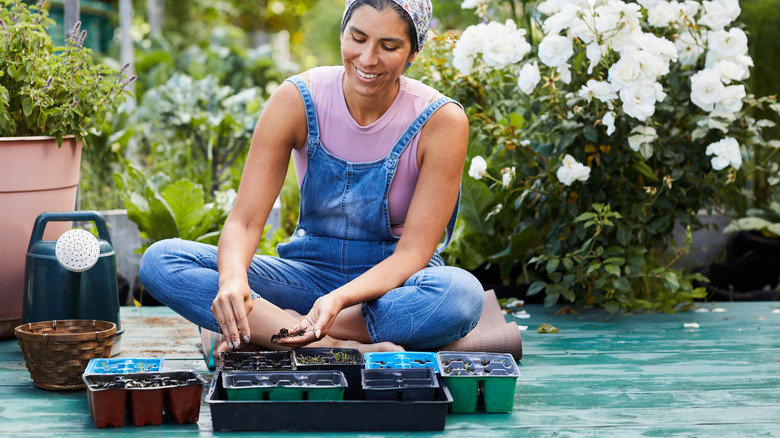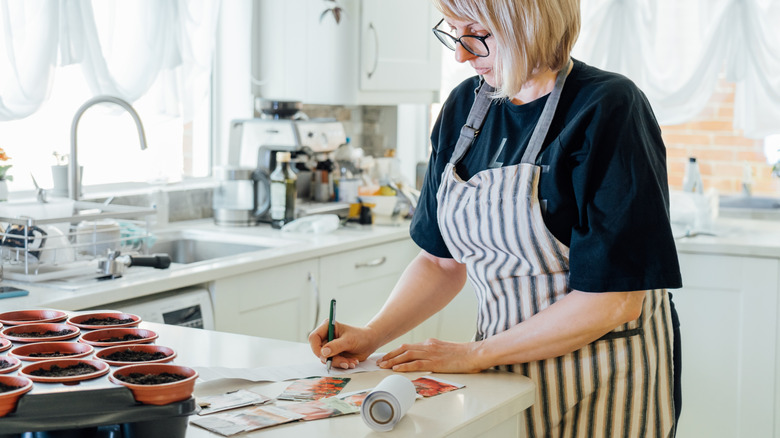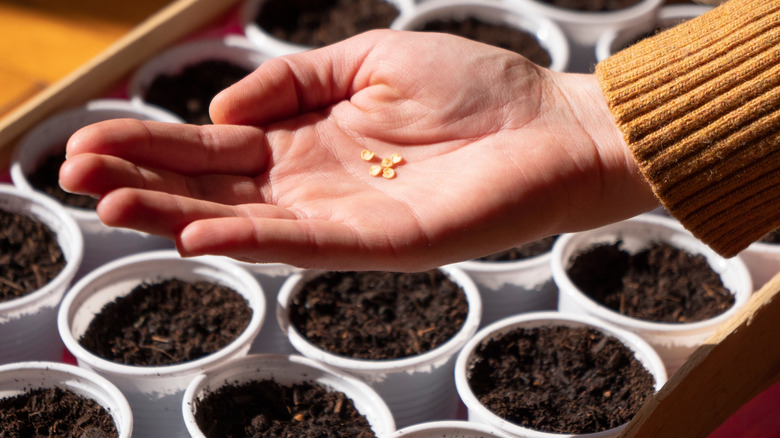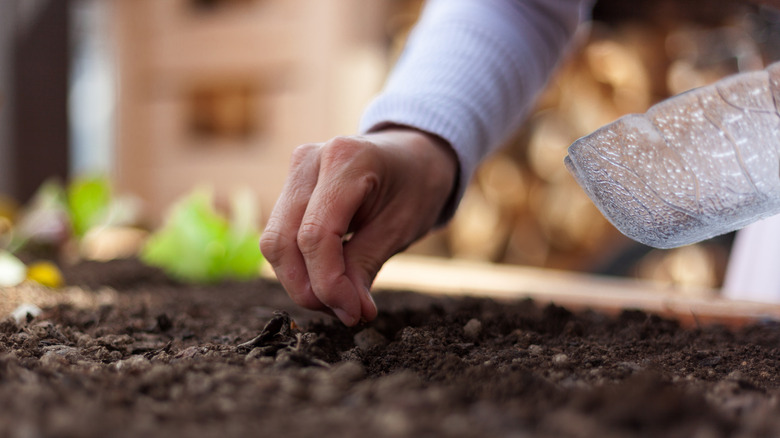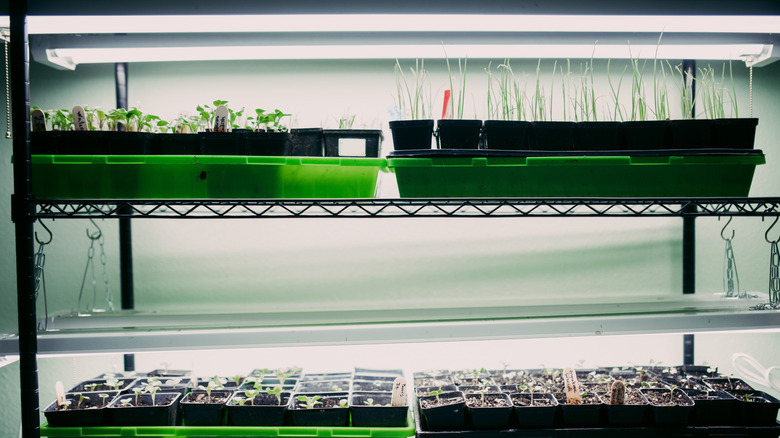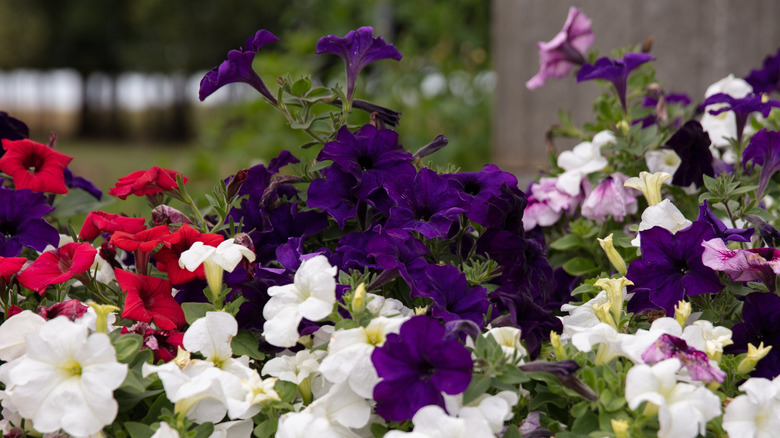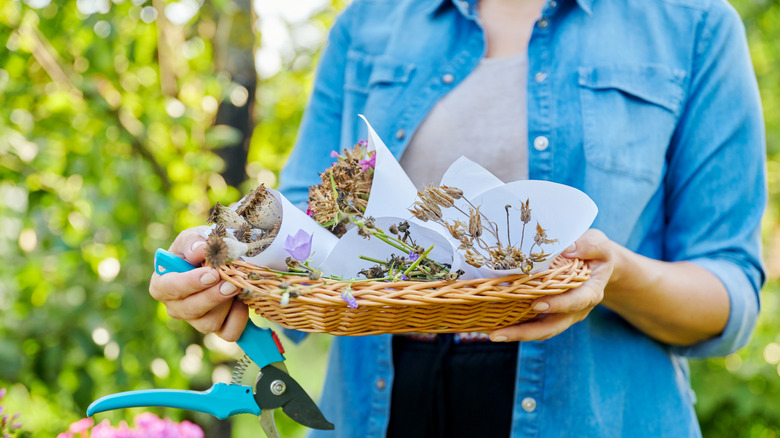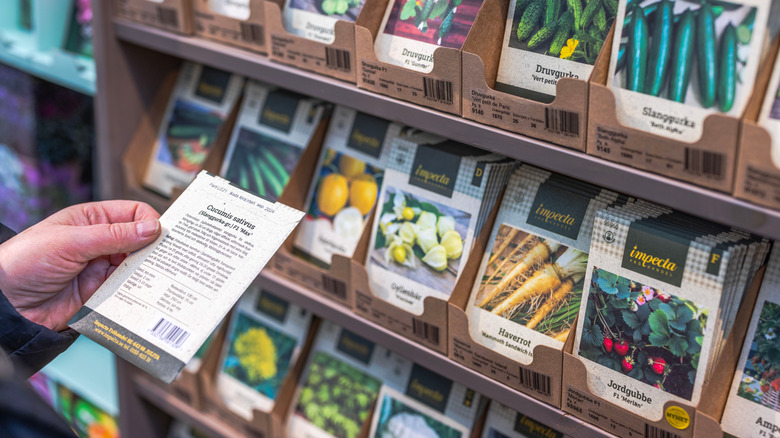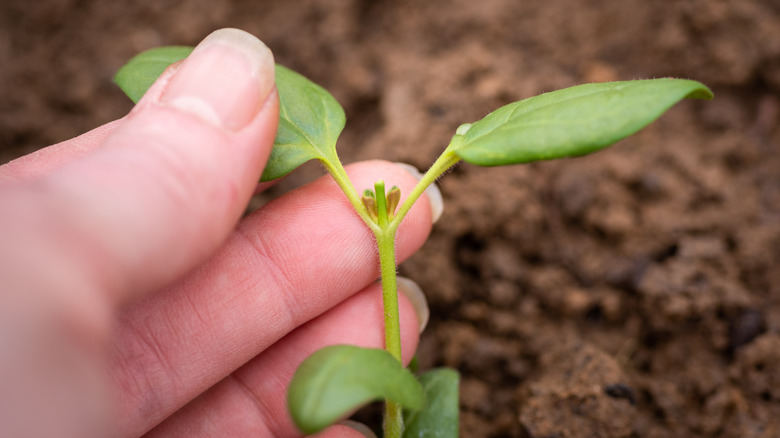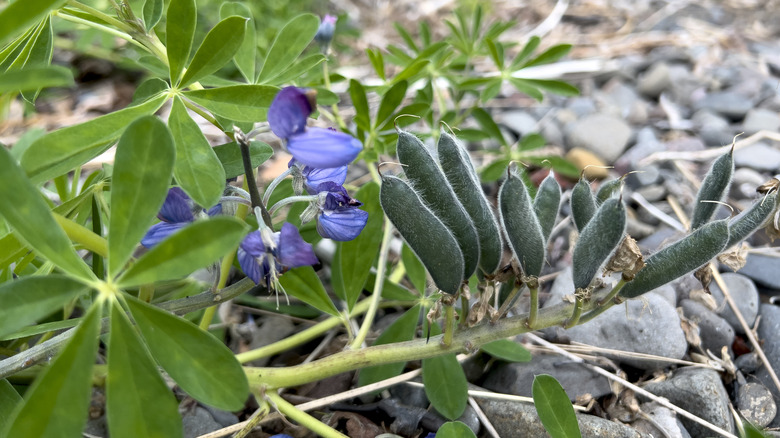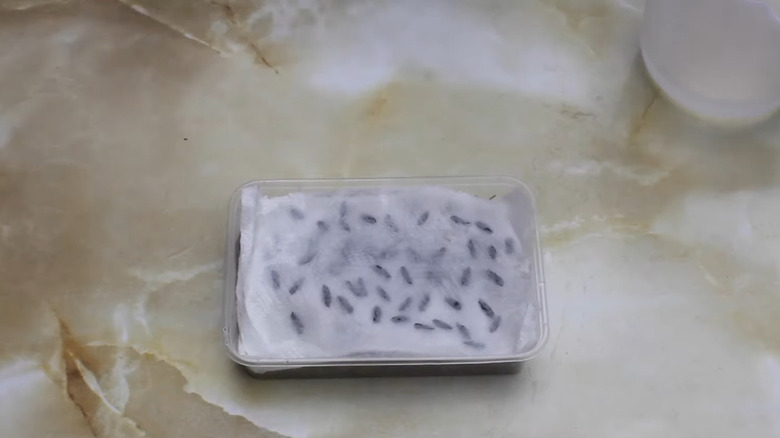Common Mistakes To Avoid When Growing Flowers From Seeds
We may receive a commission on purchases made from links.
Achieving a vibrant and colorful flower garden that puts on a display month after month is no simple task, and it can also eat into your pocketbook. What flower gardener can resist a cheerful nursery pot of bright Mexican marigolds? But if you want to save some money this season and get more blooms for your buck, growing flowers from seed is a smart move. Besides being cheaper than buying young plants from garden centers, there are also certain flowers that don't transplant well, which means sowing these from seed is a must. However, depending on the type of flower, propagating from seeds is not without its challenges and pitfalls. There are several mistakes that can stand in the way of you successfully filling up your flower garden with plants grown from seed.
Depending on the specific misstep, you might find that your seeds don't germinate properly (or at the rate you were expecting), that the flowers you thought were going to pop up through the soil aren't the same ones that are actually emerging, or that your plants end up weak and spindly — or even worse, dead. With so many potential challenges, it can be easy to throw in the trowel and give up. However, once you learn about the most common mistakes to avoid — and what you should do instead — you can find great reward in growing flowers from seeds. Continue reading to learn more so you're ready to start planting.
Not starting some of your seeds indoors
One newbie flower gardening mistake to avoid is assuming you have to wait until the weather warms up to start planting flower seeds. There are lots of plants that you can start sowing in late winter, provided you place the seed trays indoors. When the growing season arrives, the young seedlings will already be established and ready to plant out, giving you a head start and a faster flush of flowers. If you decide to plant the seeds directly in your garden, you'll have to wait for any chance of frost to be over. However, there are some flower seeds you can plant in the winter for a beautiful spring garden which can germinate in covered containers outdoors (a practice known as "winter sowing"), such as sweet William, pansies, and foxgloves.
To avoid these issues, make a plan to start some of your seeds inside, even if the weather is still pretty frigid. For best success, place your seed trays in a warm area or on a heating pad, like the Vivosun Waterproof Seedling Heat Mat. A growing light (like this versatile clip-on plant lamp from Amazon) can also help prevent lanky, weak growth. Good flower seeds to start indoors are generally those that don't mind being transplanted or are slower to germinate and grow, such as foxgloves, snapdragons, sweet Williams, and delphinium. Another thing to consider is cost. If you paid a premium for a small packet of rare hybrid or heirloom flower seeds, start these inside where you can control the conditions and get a better success rate. Pest pressure can also be something to think about. For instance, sunflowers typically do best with direct planting, but if your garden gets raided by bunnies — you might want to experiment with starting sunflowers indoors and then carefully transplanting them into the ground.
Assuming that all flower seeds should be sown at the same time
Provided you give your trays enough warmth and light, germinating seeds inside before the growing season starts isn't difficult, but there is one mistake you can make when starting seeds indoors: planting them all at the same time. The problem with this is that each type of flower is unique, and some require more time indoors than others. Starting everything at the same time may mean that some of your plants will be ready to transplant before the outdoor temperatures are warm enough. They may end up outgrowing their smaller indoor container, leaving you searching for a temporary home for them. Others may still not be large enough to be transplanted, even when the weather is warm enough for them to go outside, preventing you from getting everything moved out at the same time.
To avoid this issue, do some research to determine how early you should start each of your plants. Some flowers, such as sweet peas and zinnias, only need to be kept indoors for three to four weeks, so you can wait until around the middle of April to start them. Other flowers, however, may need two or more months inside before they're ready to be transplanted into your garden. Salvia, marigolds, hollyhocks, and annual phlox need about nine weeks, while geraniums, pansies, and wax begonias require 14 to 15 weeks. With about a 10-week difference in indoor growing times, you can easily see why starting pansies and zinnias at the same time could pose a problem.
Planting annual flower seeds outside prior to the last spring frost
While there are lots of flower seeds you can start indoors, certain flowering annuals (such as poppies, larkspur, and bells of Ireland) do best when sown directly into the ground. And some (such as cornflowers and sweet alyssum) germinate, grow, and flower so rapidly that it might not make sense to baby them indoors if you have limited space. However, when sowing directly, it's all the more important to choose the best time to plant. If you directly sow annual seeds before the final frost of the year, you're setting them up for failure. Tender annuals that are planted before the final frost are likely to suffer from frost injury. Their leaves may become limp, spotted, or otherwise damaged. In some cases, you might be able to save the plant by pruning off only the affected leaves. However, if the damage affects the entire plant, it's probably a goner. Even if temperatures don't drop below freezing, very young and particularly tender plants may still be at risk should the weather turn colder than expected. Low soil temperatures can impact the roots' ability to absorb nutrients, potentially stunting their growth.
To make sure you don't plant your seeds in the garden too early, determine when the final frost date is predicted to occur where you live. However, be warned that the predictions are just that: predictions. Since they are based on averages, there is always a possibility that the final frost comes late. If you're wondering which is more important, the last frost date versus the soil temperature when planting, both should be factored in during spring.
Giving all your flower seeds the same amount of light during germination
Before you start planting your seeds, you also want to research the ideal light conditions during germination for each type of flower you are trying to grow. This is because some flower seeds need to be exposed to light to germinate, and others prefer to be shielded from the light. Petunias, impatiens, lobelia, snapdragons, and petunias are some examples of flower seeds that require light to germinate. These seeds shouldn't be buried, but instead sprinkled on the soil surface in seed trays (you can also lightly blanket them with vermiculite or peat moss) and placed in a brightly lit position or under grow lights.
Things like cornflower, sunflower, geranium, zinnia, and nasturtium seeds germinate best in the dark. But this doesn't necessarily mean you need to keep germinating trays of these tightly sealed from light or banished to the basement. Most seeds that germinate in the dark will do just fine with the darkness they receive by being placed under the soil. That said, there are some exceptions. Very fine, small seeds (like vincas and delphiniums), don't like being planted too deep. If the packet instructions say to surface sow the seeds or only lightly sprinkle them with soil (and it's a plant whose seeds need darkness to germinate), then place these trays in a dark location until germination. Once the germination process is complete, and you have seedlings, make sure all of the plants are getting ample light. The rule about leaving some seeds in the dark applies only to the seeds themselves, not to the young seedlings — which won't be able to grow without light.
Assuming color mixes will germinate at the same time
Purchasing a color mix of a certain flower species can help add more visual appeal to your garden. For example, instead of covering a large area with only purple pansies, you can enjoy a mix of purple, yellow, orange, and white varieties. This is much more economical than purchasing multiple seed packets, each with only one color of a particular flower. However, if you are going to buy a color mix, don't be surprised if all of your seeds don't germinate at the same time. Just as germination rates can vary between flower species, it can also vary between different colors within the same variety.
It is easy to start worrying if only a small portion of your seeds are germinating. If you planted a color mix, you'll just have to trust the process and wait a few more days for some of the other colors to sprout. Similarly, once seedlings do appear, you also shouldn't be concerned if all of the leaves are not carbon copies of one another. There may be some variety between these as well.
Besides germinating at varying rates and having a different look to their leaves, certain colors might also be less vigorous growers. Therefore, when thinning directly sown seeds or transplanting from trays into the ground, don't just select the largest seedlings and cull the smaller, less vigorous-looking ones, as this could leave you with only a couple of the colors, rather than the full range.
Expecting reliable results from saved seeds
As your flowers form seeds, it may be tempting to collect and save them to plant the following year. While this isn't inherently bad — and there certainly are some seeds that you can harvest and replant — it would be a mistake to assume that the new flowers that grow will look identical to their parents. To understand this, we need to have a quick lesson on the three different types of seeds and plants.
Inbred plants self-pollinate. This means that no genes from other specimens are getting mixed in with the parent plants, so the seeds produced will have a set of genes that are nearly identical to those of their parents. These seeds can be saved and replanted with reliable results. Outcrossed plants, on the other hand, are not self-pollinating and need the pollen from another plant to form seeds. Because two sets of genes are being combined, there will be more variation in the seeds that are produced from cross-pollination. Some seeds may grow to look like the parents, others may look completely different, and some may not even sprout. Only save these seeds if you're happy to have some surprises. Finally, some plants are considered hybrids. These are created when two inbred lines are crossed. When hybrids cross-pollinate, the mixture of genes is completely random, and you never know what you're going to get, so saving these seeds will be a gamble.
There's another reason you might want to avoid saving seeds from your garden. It is possible that the seeds may be contaminated with a disease from the parent plant. As an example, zinnias can pass down blight via their seeds. Planting infected seeds would start your garden off on the back foot.
Not checking the seed packet for important information
While there are some general guidelines that can help you grow many different flowers from seeds, nothing beats getting your information straight from the source. And, what better source than the seed packet itself? Always check the information printed on the packaging before you sow. It should include guidelines around spacing the seeds, how deep you should plant them, and what you should do to care for newly emerged seedlings. A seed packet should also answer your questions about germination — such as how long the seeds will take to sprout or what conditions are best for the process to occur.
Another reason to always read over the seed packet before you start planting is to confirm that you have newer seeds. Just as many food items have a "best-by" date, the same is true for seeds. If you look over the packet, you should be able to find a "sell-by" date. Confirming that your seeds are from the current season will help ensure that they germinate and grow vigorously. If you have an old seed packet that's been lying around for a few years, you might want to just purchase a new one, since seeds lose their viability over time, demonstrating decreased germination rates and vigor.
Failing to pinch young plants
If you're not pinching your young plants, you might be robbing yourself of blooms. Pinching refers to cutting off the terminal shoot of a plant. This terminal growth refers to anything above the apical bud or the first set of true leaves of the plant. The true leaves are those that resemble what the leaves on the full-grown plant will look like, they are not the first leaves that you'll see once the plant sprouts. When you pinch young plants, it encourages lateral buds, resulting in fuller growth. Extra flower buds can develop on the resulting side shoots, giving you more blooms per plant than if you had let it develop a single stem. You can pinch young plants using your fingers (literally pinching off the growth above the apical bud) or with a pair of sharp scissors. To prevent spreading disease between different trays or types of seedlings, wash your hands or sterilize your tools after handling infected plants.
There are several types of flowers that can benefit from pinching. Some of these include impatiens, snapdragons, petunias, zinnias, and cosmos. However, before you go crazy pinching all of your plants, it is important to note that there are also a few flowers you should not pinch, as you may actually cause damage to them. These include delphiniums, cockscombs, larkspurs, and most varieties of sunflowers.
Not scarifying certain flower seeds
The seeds of some flowering plants contain natural inhibitors to prevent them from sprouting to life before the right conditions are present. One of these is the toughness of the outer protective layer. Scarification can help increase germination rates for perennial and annual seeds that have thicker outer coatings. Perennials are typically more difficult to germinate than annuals, and may be more likely to require scarification — but there are also certain annuals (like morning glory and sweet peas) that will germinate quicker with scarification. Lupine and columbine are two examples of perennial flower seeds that can benefit from scarification.
Scarification involves breaking down the seed coat enough so that water will be able to get in and start the process of germination, mimicking what occurs in nature before seeds sprout. If you have larger seeds, you can try using a sharp knife to make a few nicks in the hard, outer covering. For smaller seeds, rub them with some sandpaper to wear down the coating. Some seeds (usually the ones with particularly hard shells) require both scarification and soaking.
Not cold stratifying certain flower seeds
In addition to the scarification techniques that are sometimes needed to prepare seeds for germination, you may also need to cold stratify certain flower seeds. This is another technique that is designed to mimic the conditions seeds would face when they are outside during a cold winter. Some seeds have to experience a stretch of cold temperatures in order to come out of dormancy. Many perennials can benefit from cold stratification, as well as some annuals. A few examples include purple coneflowers, milkweed, lavender, catmint, Eastern red columbine, foxgloves, and black-eyed Susan.
Seed stratification involves exposing the seeds to these cold conditions. One way to do this is by placing them in the refrigerator. Dampen a paper towel and wrap the seeds up inside of it. Place everything inside a sealed bag, and put the bag into the refrigerator for up to three months (the ideal period can depend on the flower species). Monitor the seeds and make sure that too much moisture isn't accumulating. Once the stratification period is over, you'll be ready to germinate the seeds. Alternatively, you can opt for natural cold stratification by sowing certain seeds (like poppies) in the fall. One of the benefits of direct sowing versus starting seeds indoors when growing flowers is that autumn seed planting can allow for automatic stratification.
